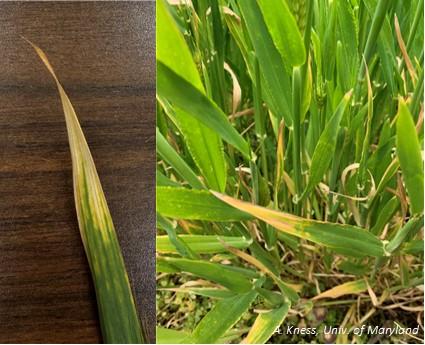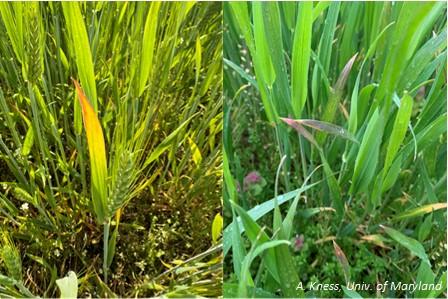
Figure 1. Wheat leaves with symptoms of leaf tip necrosis. Note the dead tissue at the leaf tips. Photo: A. Kness, University of Maryland
Wheat Leaf Tip Necrosis Showing in Many Wheat Fields

Over the past couple of weeks we have gotten several questions about yellowing flag leaves on wheat. Generally these symptoms are appearing widespread in fields. To the best of our knowledge we can attribute this to leaf burn or leaf tip necrosis (LTN) (Figure 1). This disorder is often a response to cold injury or wind, but can also manifest as a result of heat and drought stress. We have had widespread hot and dry conditions for several weeks across Maryland, which can trigger these symptoms, especially on lighter soils. These symptoms can also be intensified by specific leaf rust and stripe rust resistance genes and LTN severity can vary greatly between varieties. In any case, there is nothing you can do to remedy the situation.
Leaf tip necrosis may be confused with barley yellow dwarf virus (BYDV). BYDV is undoubtedly contributing to some of the symptoms in many of these fields, but it is probably not the sole factor causing these symptoms. LTN tends to cause death of the leaf tip resulting in necrotic brown tissue (Figure 1), whereas BYDV can cause a range of symptoms from yellowing of the leaf, which may or may not be accompanied with bronzing/purpling of the leaf tips (Figure 2). Notably with BYD, leaf tips do not die and become necrotic; whereas leaf tissue from LTN will become brown and dead starting at the leaf margins near the tip and work inward. Since BYDV is vectored by aphids, symptoms tend to be localized in hotspots in a field where aphids populations are high, whereas leaf burn and LTN more uniformly affect the entire field.
This article appears in May 2024, Volume 15, Issue 2 of the Agronomy News.
Agronomy News, May 2024, Vol. 15, Issue 2
Agronomy News is a statewide newsletter for farmers, consultants, researchers, and educators interested in grain and row crop forage production systems. This newsletter is published once a month during the growing season and will include topics pertinent to agronomic crop production. Subscribers will receive an email with the latest edition.
Subscribe